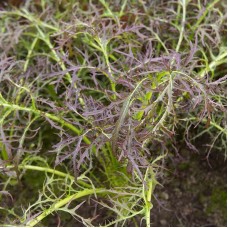Brassica juncea - 400 seeds
Purple Frills is a mustard variety with fine incised, deep purple leaves and a spicy taste. Mustard leaf has been grown and eaten in the Himalaya region in India for over 5000 years. Also in many other countries is leaf mustard a part of the daily menu. It can be prepared as spinach and other leaf vegetables, and it can be eaten in both early and mature stage. The plants bolter fast when they are planted in early summer, although they then produce lovely yellow, consumable flowers. Sowing and harvesting can be performed later due to its winter hardiness.
Leaf mustard comes in an array of shapes and sizes; they vary from small leaved to large; from yellow-green to purple, to deep, dark green. Some varieties have softly rounded, very large leaves with very thick stems, others are more delicate with thin, deeply serrated, smaller leaves and thin stems
If you want colour, choose the beautiful Mustard ‘Red Frills’. True to its name, the attractive and sweet leaves are finely serrated when young, then look more like mizuna when mature. The fringed burgundy-red leaves add the taste of mustard and horseradish to salads, stir fries and sandwiches.
Oriental mustards pack a peppery dijon-like wallop in salads. They are fantastic when lightly steamed, stir-fried or sautéed. Use in bean soups, julienned, or as a substitute for spinach in your quiche. They are also delicious with cold beef dishes instead of horseradish or simply add to salads for a unique flavour.
They can be sown little and often and eaten as mini micro greens or used as a garnish. Alternately grow until the leaves are a few centimetres in size and use in a baby leaf salad and mesclun mixes. Left to grow to full size, whole heads can be harvested, or pick individual mature leaves one or two at a time and the plant will continue to grow.
Easy to grow, Mustard Red Frills is a good-looking plant, the large, red-tinged leaves intensifying to deep burgundy purple in cold weather. In the garden it looks gorgeous whether partnered with flowers, herbs and other vegetables. It is both ‘cold and bolt’ tolerant and often to be found in the ornamental garden or the potager, where it adds colour from autumn right through to spring. As a final encore, if allowed to flower, it has incredible yellow flowers that emerge as a tall spike out of its centre.
Position:
Mustard grows best in a sunny position in a fertile soil. It can be sown directly into open ground or can be planted into grow bags. If grown for babyleaf it can be sown into small containers or even windowboxes. Choose a well-drained container that's at least 10 to 15cm (4 to 6in) deep. Containers may need to be watered a couple times a day when temperatures begin to warm. If growing micro-greens, seeds can be planted in shallow flats and harvested about 10 to 21 days after planting. If given adequate light, they can also be grown indoors during the winter.
Sowing: Sow under cover February to May or sow direct April to October
Mustard seeds can be sown practically year round. Plant little and often, every two weeks for continuous supply. Seeds germinate in 5 to 10 days at temperatures between 7 to 30°C (45 to 85°F)
Sow sparingly in shallow drills 6 to 12mm (¼ to ½ in) deep. Space seeds 2.5cm (1in) apart for cut-and-come-again salad or 20 to 25cm (8 to 10in) for whole plant production. Adequate spacing is most important when growing plants to full size. This is easy to accomplish by simply thinning plants as they begin to get crowded in the garden.
Cultivation:
Mustard greens are primarily a cool season vegetable and are at their peak in late spring to early summer. Keep well watered especially in summer. Hot weather causes the plants to bolt and their greens to turn unpleasantly bitter.
An autumn crop is often planted because mustard is frost-resistant and easily overwinters in temperate areas. Protect late sowings with cloches and the plants will keep growing throughout the winter and continue to grow vigorously when temperatures warm and daylight increases.
Harvesting: 20 days for babyleaf, 45 days to maturity
Mustard plants can be harvested for baby leaf once the leaves are 5cm (2in) tall. For milder leaves, pick young, they are best cropped at around 15cm (6in) for salads.
The plants will grow to around 30 to 45cm (12 to 18in) tall. Mature leaves can be boiled or steamed or braised in a pot with a little butter and garlic.
Use scissors or a knife rather than pulling the leaves to avoid damaging the plant. Keep picking regularly to prevent flowers running to seed. Pull and compost the plants once hot weather arrives in the summer, as mustard greens become tough and bitter.
| j | f | m | a | m | j | j | a | s | o | n | d | |
| direct sowing | ||||||||||||
| harvest |
| j | f | m | a | m | j | j | a | s | o | n | d | |
| direct sowing | ||||||||||||
| harvest |
Leaf Mustard 'Purple Frills'
- Product Code: ORPF
- Availability: In Stock
-
€2.75
- Ex Tax: €2.75


